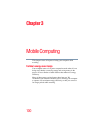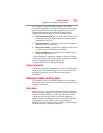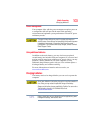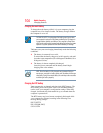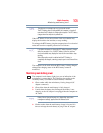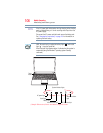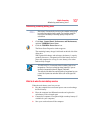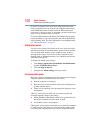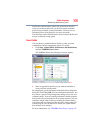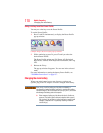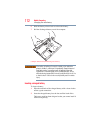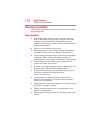
108
Mobile Computing
Monitoring main battery power
If you do not manage to do any of these things before the main
battery completely runs out of power, the computer automatically
enters Hibernation mode and turns itself off. Hibernation mode
keeps track of where you were, so that when you turn on the power
again, you can continue where you left off.
If you have Hibernation mode enabled (the default), the computer
copies the details of your open programs and files to the hard disk
before shutting down. For more information on using Hibernation,
see “Hibernation mode” on page 73.
Setting battery alarms
You can set two alarms. Each alarm can be set to alert you when a
specified percentage of remaining battery power has been reached.
You can set how the warning occurs: sound an alarm, display a
message, both, or none. You can also set the computer to enter
Standby mode or Hibernation mode or to completely power down
when the alarm goes off.
To change the default alarm settings:
1 Click Start, Control Panel, Performance and Maintenance,
and then TOSHIBA Power Saver.
2 Click the Setup Action tab.
3 Configure the Alarm settings to suit your needs.
Conserving battery power
How long a fully charged battery pack lasts when you are using the
computer depends on a number of factors, such as:
❖ How the computer is configured
❖ How much you use the hard disk, optical drive, diskette drives,
or other optional devices
❖ Where you are working, since operating time decreases at low
temperatures
There are various ways in which you can conserve power and
extend the operating time of your battery:
❖ Enable Standby or Hibernation, which saves power when you
turn off the computer and turn it back on again
❖ Use Toshiba’s power-saving options
These power-saving options control the way in which the computer
is configured. By using them, you can increase the length of time
you can use the computer before you need to recharge the battery.



